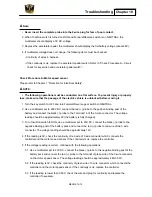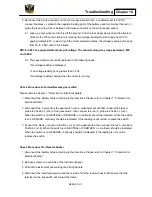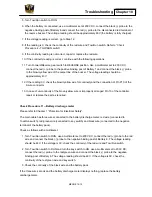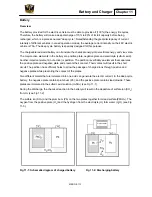
Battery and Charger
MERGE 11-6
Chapter 11
liquid level benchmark. This is because the liquid level of electrolyte may rise when the battery is
charged. Some electrolyte may burst out of the battery cover. Therefore, filling water to the liquid level
before battery charging may result in the spillage. This will reduce the battery capacity and corrode its
neighboring metal components.
The electrolyte liquid level should be inspected once a week to ensure that the electrolyte is maintained
at the normal liquid level (see Fig 11-6)
.
Never allow the electrolyte be lower than the top of the positive
and negative plates, as this will result in the permanent inertia of exposed plates. To achieve the
optimum result, please fill water into the battery with watering gun. In hot weather or when the battery
becomes aged, the liquid level of electrolyte should be inspected more frequently.
Mineral content
To prolong battery life to the longest possible degree, the battery should be filled with distilled water. In
case tap water is to be used, the water must be ensured to contain minerals of which the contents are
below the level specified below:
Impurities
Allowable content (ppm)
Suspended
substance
Cannot be viewed visibly
Total solid
100.0
Calcium and
magnesium oxides
40.0
Iron 5.0
Ammonia 8.0
Organic matter
50.0
Nitrate 10.0
Nitrite 5.0
Chloride 5.0
Vibration damage
The battery hold-down gear should remain tight and secure to prevent the battery from jumping out. In
case the battery hold-down gear is too loose, the service life of the battery may be shortened to a great
extent. Secure the hold-down gear with a load of 40 in-lb (4.5 N
·
m). With too strong vibration, the
positive and negative plates may come off prematurely and the battery life may be shortened. It may also
result in the leakage of acid fluid from air bleeder cover and in the accumulation of rust and dirt on the
neighboring metal components. The lost acid fluid may reduce the battery capacity and cannot be
replaced. However, the battery hold-down gear shouldn't be too tight, so as to prevent the battery
enclosure from being fractured or bent. This will result in leakage, and further to the dry-up of the battery
compartment or short circuit. Please refer to Chapter 1 “Protection for Electrical Safety”.
Summary of Contents for 2010 E-Merge
Page 2: ......
Page 79: ...Electric Component MERGE 9 7 Chapter 9 Control circuit ...















































